

What Dante Saw
Dante Alighieri (1265-1321) is both the founder and the best knoewn poet of Italian literature. His poem
La Divina Commedia, a journey through Hell, Purgatory and Heaven, was written in volgare the everyday language
spoken in Florence which mainly because of the success of the poem became the basis of Italian and in a sense of the Italian nation.
The verses have eleven syllables and are grouped in triplets rhyming aba, bcb, cdc, etc..
The poem has many references of a general nature which reflect the feelings of Dante towards the great past of Rome.
Dante visited Rome in 1301 as a member of a delegation sent to Rome to try to understand the objectives of Pope Bonifatius VIII, who had repeatedly tried
to influence political developments in Florence: some specific references he made in his poem to Roman sites are no doubt related to that journey.
There are several English translations of La Divina Commedia, the best known being that by Henry Wadsworth Longfellow (used in this page) who
chose to keep very close to the original, even when the structure of the sentence did not suit English syntax.
A Selection of General References
Purgatorio, Canto XVI
Soleva Roma, che 'l buon mondo feo,
Due soli aver, che l'una e l'altra strada
Facean vedere, e del mondo e di Deo. | Purgatorio, Canto XVI
Rome, that reformed the world, accustomed was
Two suns to have, which one road and the other,
Of God and of the world, made manifest.
| At the times of Dante, the Italian city-states were split between those supporting the Pope
(Guelphs) and those supporting the Emperor (Ghibellins): the split often existed inside each city with political factions claiming
to support one or the other. The split had much more to do with business than ideals. So because Pisa was Ghibellin, Florence turned
Guelph and in Florence the Guelphs were split into White Guelphs and Black Guelphs. Dante supported the White Guelphs, but
while he was in Rome, Charles of Valois, brother of the king of France, acting as envoy of the Pope, entered Florence with a small army
to settle the disputes between the two Guelph parties. He favoured the appointment of a new Black Guelph government
and the subsequent ousting of the members of the rival party. Dante never returned to Florence and for twenty years
he lived at the courts of Italian princes, mostly in Verona and Ravenna where he died in 1321.
He expressed his political theories in a lengthy treaty (De Monarchia) and in a more effective way in describing the two suns of Rome (the Pope and the Emperor)
each enlightening a specific aspect of life. The historical reference is rather forced because the recognition of the Christian religion by Constantine almost coincided
with the move of the Empire capital to Constantinople.
The picture shows a detail of dum U dvou sluncu (house At the two suns), 47 Nerudova, Prague. | 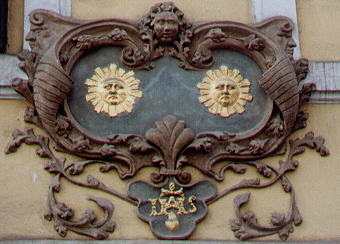 |
Paradiso, Canto XXXI
Se i barbari, venendo da tal plaga
Che ciascun giorno d'Elice si cuopra,
Rotante col suo figlio ond'ella è vaga,
Veggendo Roma e l'ardua sua opra,
Stupefaciensi,....
| Paradiso, Canto XXXI
If the barbarians, coming from some region
That every day by Helice is covered,
Revolving with her son whom she delights in,
Beholding Rome and all her noble works,
Were wonder-struck, ....
| La Divina Commedia abounds in comparisons, which are often
the highest points of the poem.
After the long journey through Hell and Purgatory and nearing the end
of his tour of Heaven, Dante is admitted to the vision of the saints and he compares his wonder at this sight,
with that of a barbarian coming from northern Europe (the regions under the nymph Helice, a symbol of the Great Bear), who
first sees Rome.
The impact of first seeing Rome was described by many Latin writers, including Virgil who is the guide of Dante
in the poem (in Hell and Purgatory).
The picture shows a detail of a statue of a barbarian prisoner
in Arco di Costantino: the face was restored by Pietro Bracci in 1733.
| 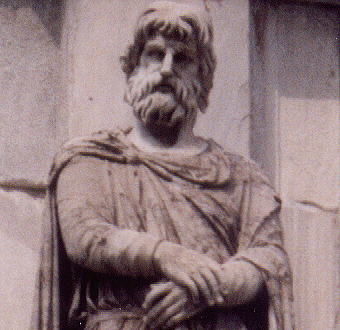 |
Purgatorio, Canto VI
Vieni a veder la tua Roma che piagne
Vedova e sola, e dì e notte chiama:
"Cesare mio, perchè non m'accompagne?". | Purgatorio, Canto VI
Come and behold thy Rome, that is lamenting,
Widowed, alone, and day and night exclaims,
"My Caesar, why hast thou forsaken me?"
|
In these verses Dante made an appeal for intervention to the (German) Emperor
who neglected his duties and left Rome in a state of abandonment (when Dante wrote them even the Pope had abandoned Rome),
but the triplet expresses a more general nostalgia for a past of fame and power.
The glory of the past compared with today's misery and in general the heritage of ancient Rome
is something Italians have had to deal with for centuries. From the vindication of direct links with ancient Rome of many Italian
cities (such as Venice and Siena) to the attempts to revive the Roman empire by Mussolini, the past continues
to influence the way Italians see themselves (and foreigners see Italians).
The picture shows a detail of an ancient statue called Tusnelda or Germania vinta in Loggia della Signoria in Florence.
| 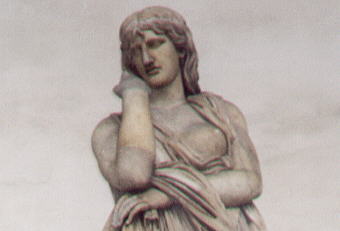 |
Specific references:
Ponte S. Angelo Inferno, Canto XVIII
Nel fondo erano ignudi i peccatori;
Dal mezzo in qua ci venien verso 'l volto,
Di là con noi, ma con passi maggiori,
Come i Roman per l'essercito
molto,
L'anno del giubileo, su per lo ponte
Hanno a passar la gente modo colto,
Che da l'un lato tutti hanno
la fronte
Verso 'l castello e vanno a Santo Pietro,
Da l'altra sponda vanno verso 'l monte.
|
Ponte S. Angelo
Down at the bottom were the sinners naked;
This side the middle came they facing us,
Beyond it, with us, but with greater steps;
Even as the Romans, for the mighty host,
The year of Jubilee, upon the bridge,
Have chosen a mode to pass the people over;
For all upon one side towards the Castle
Their faces have, and go unto St. Peter's;
On the other side they go towards the Mountain.
|
Many believe that this comparison made by Dante between
the orderly flows of sinners in Hell and of pilgrims during the Holy Year 1300 is evidence that Dante was in Rome
during that year, but the matter is still debated.
Pope Bonifatius VIII called the first Jubilee or Holy Year
in the year 1300 and the number of pilgrims was extremely high so that some sort of "stand on the right" rules
had to be implemented to facilitate the access to St. Peter's.
The bridge
quoted by Dante is Ponte S. Angelo, the Castle is Castel Sant'Angelo
and the Mountain is Palazzo di Monte Giordano.
The picture shows a fresco in the courtyard of S. Gregorio Magno portraying
the vision of an angel announcing the end of a pestilence. The fresco shows how the bridge and the castle looked
at the beginning of the XVIIth century. | 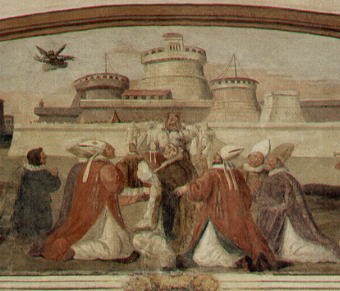 |
Orsini Family Inferno, Canto XIX
... «Dunque che a me richiedi?
Se di saper ch'i' sia ti cal
cotanto,
Che tu abbi però la ripa corsa,
Sappi ch'i' fui vestito del gran manto;
E veramente fui figliuol de
l'orsa,
Cupido sì per avanzar li orsatti,
Che sù l'avere e qui me misi in borsa. |
Orsini Family
..."Then what wantest thou of me?
If who I am thou carest so much to know,
That thou on that account hast crossed the bank,
Know that I vested was with the great mantle;
And truly was I son of the She-bear,
So eager to advance the cubs, that wealth
Above, and here myself, I pocketed.
|
Dante was particularly angered by the simoniac behaviour of some popes
who sold ecclesiastical preferments for their own profit. He shows them in Hell, stuck upside down in narrow holes in the ground
with their feet on fire.
The verses describe the meeting between Dante and Nicholaus III, Giovanni Gaetano Orsini, pope in 1277-80, who admits
his wrongdoings by using a metaphor making reference to the family symbol, the bear. The bear is known for being
very gluttonous. His acts, aimed at favouring by all means his nephews, brought him wealth above
(on Earth) and pain in Hell.
The picture shows a plinth now in the Vatican Grottoes and once
a part of the lost monument to Nicholaus III in old St. Peter's. The left side shows the Orsini coat of arms while the right side
shows a bear, the family symbol (Orsini = little bears). | 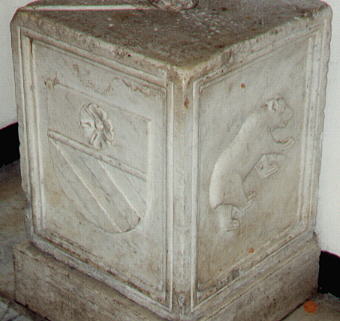 | Aventino Inferno, Canto XXV
Lo mio maestro disse: «Questi è Caco,
Che, sotto 'l sasso di monte Aventino,
Di sangue fece spesse volte laco.
Non va co' suoi fratei per
un cammino,
Per lo furto che frodolente fece
Del grande armento ch'elli ebbe a vicino;
Onde cessar le sue opere biece
Sotto la mazza d'Ercule, che forse
Gliene diè cento, e non sentì le diece».
|
Aventino
My Master said: "That one is Cacus, who
Beneath the rock upon Mount Aventine
Created oftentimes a lake of blood.
He goes not on the same road with his brothers,
By reason of the fraudulent theft he made
Of the great herd, which he had near to him;
Whereat his tortuous actions ceased beneath
The mace of Hercules, who peradventure
Gave him a hundred, and he felt not ten."
|
According to the myth, Cacus was a centaur
who lived in a deep cave in the valley between the Palatine and the Aventine: he stole the two finest bulls of Heracles, by dragging them
backwards by their tails into his lair. Heracles noticed that the cattle were missing and searched in vain for them.
He had decided to move on with the remaining herd when the bulls hungrily lowed and Heracles was able to trace
the cave where they were kept. He was so angry that he battered Cacus' face to pulp and he went on hitting him
well after his death.
When Dante visited Rome the Aventine was abandoned (with the exception of the monasteries of S. Sabina and
S. Alessio). The arches of the walls built by the Romans on the southern steep corner of the hill were covered by
spontaneous vegetation: they had the appearance of cave entrances.
The episodes narrated in the poem became so widely known in Florence
that a gigantic statue inspired by Dante's description of Hercules and Cacus was put (and still is) at the entrance
of Palazzo Vecchio, opposite the statue (now a copy) of Michelangelo's David.
The picture shows a detail of this statue by Baccio Bandinelli. | 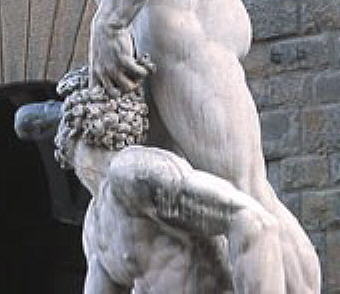 |
Laterano Inferno, Canto XXVII
Lo principe d'i novi Farisei,
Avendo guerra presso a Laterano,
E non con Saracin né con Giudei,
Ché ciascun suo nimico era
Cristiano,
E nessun era stato a vincer Acri
Né mercatante in terra di Soldano;
|
Laterano
The Leader of the modern Pharisees
Having a war near unto Lateran,
And not with Saracens nor with the Jews,
For each one of his enemies was Christian,
And none of them had been to conquer Acre,
Nor merchandising in the Sultan's land;
|
Bonifatius VIII was perhaps the person Dante despised most. Very often Dante did not explicitly call by
their name the various personages he met in his journey, but he used an indirect approach. For Bonifatius VIII he chose the infamous title of Prince of the Pharisees and
he pointed out that he waged war against other Christians and not against the followers of other religions.
The words near unto Lateran in these verses stand for "with the members of the Colonna family", with whom Bonifatius VIII engaged in repeated fights.
The Colonna threatened the Lateran, then the residence of the pope, from their fortifications on the Qurinale hill.
It was from a loggia in the Lateran, that Bonifatius VIII announced the first Jubilee.
The picture shows a fresco in
S. Giovanni in Laterano portraying
the moment of the announcement. In the past the fresco was attributed to Giotto. | 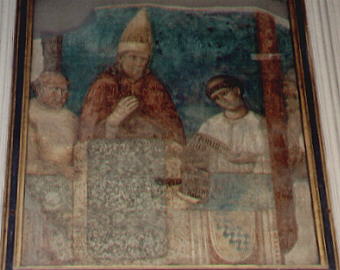 |
Pigna del Vaticano Inferno, Canto XXXI
La faccia sua mi parea lunga
e grossa
Come la pina di San Pietro a Roma,
E a sua proporzione eran l'altre ossa;
|
Pigna del Vaticano
His face appeared to me as long and large
As is at Rome the pine-cone of Saint Peter's,
And in proportion were the other bones;
|
Dante, in order to describe the size of the giant Nimrod's face, compared it
with the bronze pine-cone which once stood at the entrance of St. Peter's. Nimrod was the king of Babylon
who wanted to build a tower to reach the sky. The pine-cone, once a Roman fountain, is now in Cortile della Pigna in the Vatican.
A quarter of Rome (between S. Maria sopra Minerva and Via del Corso) is named after it.
The French painter
Gustave Dorè (1832-83) is one of the best
known illustrators of La Divina Commedia: he drew gigantic, muscular figures clearly inspired after works by Michelangelo.
Before him,
Edward Blake (1757-1827) had illustrated some episodes of the poem in a more spiritual manner.
The image shows an illustration of
the meeting between Dante and the Giants by Gustave Dorè. | 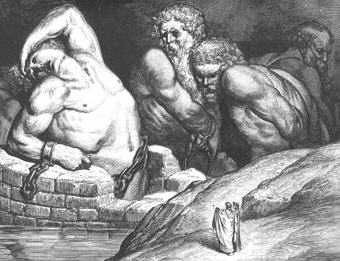 |
Rupe Tarpea Purgatorio, Canto IX
E quando fuor ne' cardini distorti
Li spigoli di quella regge sacra,
Che di metallo son sonanti e forti,
Non rugghiò sì nè si mostrò sì acra
Tarpea, come tolto le fu il buono
Metello, per che poi rimase macra.
|
Rupe Tarpea
And when upon their hinges were turned round
The swivels of that consecrated gate,
Which are of metal, massive and sonorous,
Roared not so loud, nor so discordant seemed
Tarpeia, when was ta'en from it the good
Metellus, wherefore meagre it remained.
|
A mountain was the traditional representation of Purgatory. At its base an angel watched the heavy
gate which controlled the access to it. Dante compared the sound he heard when the gate was opened to allow him and Virgil
to continue their journey, with the sound of the doors of the Aerarium, the Roman Treasury, when Julius Caesar had them forced to take possession
of its contents.
The Treasury was located immediately
below Rupe Tarpea and the main temple of Rome dedicated to Jupiter.
The tribune Lucius Cecilius Metellus was the custodian of the Treasury and he vainly
opposed Julius Caesar.
Because the hill above the building
slid down during the Middle Ages, at the time of Dante nothing of it was visible. It is therefore possible that Dante had in mind the bronze panels of the nearby
Curia Julia which were still in place (although the building had been turned into
a church dedicated to S. Adriano). In the XVIIth century the bronze panels
were moved to S. Giovanni in Laterano to close the main door of the
basilica, which had been renovated by Francesco Borromini in 1644-55.
The image shows the lower bronze panels of the main door of S. Giovanni in Laterano. They were framed in a
decoration showing the heraldic symbols of Pope Alexander VII. | 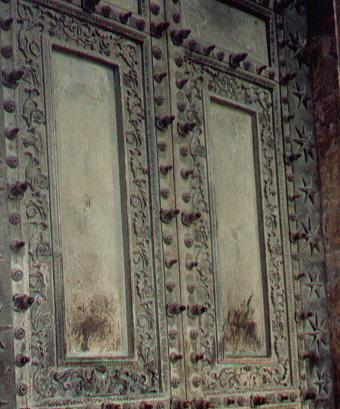 |
Colonna Traiana Purgatorio, Canto X
I' mossi i piè' del loco dov'io stava,
Per avvisar da presso un'altra istoria,
Che di dietro a Micol mi biancheggiava.
Quiv'era storiata l'alta gloria
Del roman principato, il cui valore
Mosse Gregorio a la sua gran vittoria;
I' dico di Traiano imperadore;
E una vedovella li era al freno,
Di lagrime atteggiata e di dolore.
Intorno a lui parea calcato e pieno
Di cavalieri, e l'aguglie ne l'oro
Sovr'essi in vista al vento si movieno.
|
Colonna Traiana
I moved my feet from where I had been standing,
To examine near at hand another story,
Which after Michal glimmered white upon me.
There the high glory of the Roman Prince
Was chronicled, whose great beneficence
Moved Gregory to his great victory;
'Tis of the Emperor Trajan I am speaking;
And a poor widow at his bridle stood,
In attitude of weeping and of grief.
Around about him seemed it thronged and full
Of cavaliers, and the eagles in the gold
Above them visibly in the wind were moving.
|
The most famous Roman emperors were pagan, but some of them were rescued from Hell.
Trajan was pardoned and moved to Purgatory due to the intercession of St. Gregory who prayed for his soul.
Dante described (without being specific about Colonna Traiana)
a marble relief showing the events of Trajan's reign. He made reference to a legendary episode in which the emperor delayed
his departure for war to render justice to a widow. Trajan is portrayed among a host of chevaliers with golden eagles (the Roman standards)
moving in the wind.
In the reliefs of Colonna Traiana some small objects like lances and standards were cast in gilded bronze and
put in the hands of the marble figures. Because in Colonna Traiana the emperor was usually portrayed while he delivered a speech to the troops,
Dante might have had in mind later reliefs where the emperors were shown leading their cavalry.
The image shows the high relief once at the base of Colonna Antonina and now in the Vatican Museums. | 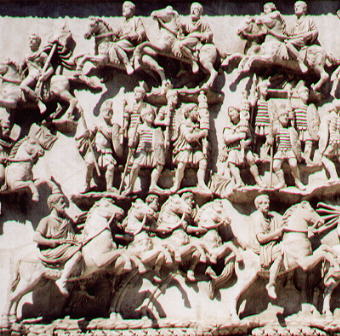 |
The backgrounds of the two tables above show portraits of Dante by Raphael (frescoes in the Vatican).
Read What Goethe Saw.
Read What Lord Byron Saw.
Read What Charles Dickens Saw.
Read What Mark Twain Saw.
Read What Henry James Saw.
Read What William Dean Howells Saw.
Directories

Go to  or to
The Coats of Arms of the Popes or
to My Home Page on Baroque Rome or to
My Home Page on Rome in the footsteps of an XVIIIth century traveller or to
The Coats of Arms of the Popes or
to My Home Page on Baroque Rome or to
My Home Page on Rome in the footsteps of an XVIIIth century traveller

|


 or to
The Coats of Arms of the Popes or
to My Home Page on Baroque Rome or to
My Home Page on Rome in the footsteps of an XVIIIth century traveller
or to
The Coats of Arms of the Popes or
to My Home Page on Baroque Rome or to
My Home Page on Rome in the footsteps of an XVIIIth century traveller









